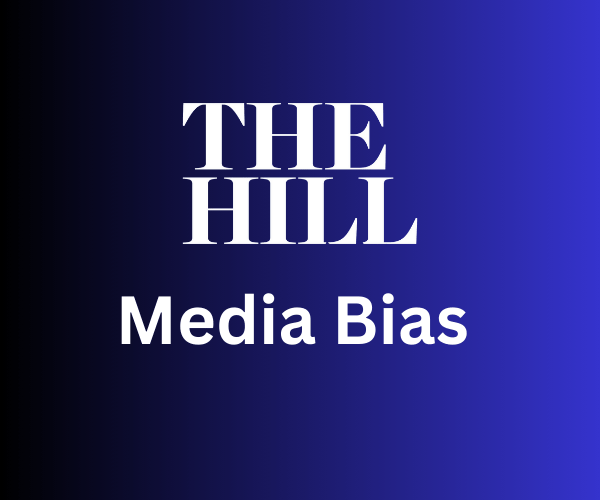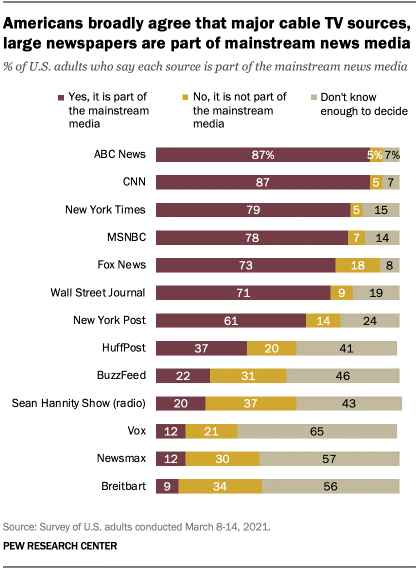
The Hill, established in 1994 “serves to connect the players, define the issues and engage Washington’s decision makers in the debate” (About Us). With a primary focus on the intersection of politics and business, the Hill offers in-depth coverage on American politics, including coverage of the Congress, the Presidential Administration, business and lobbying, campaigning, and more.
With a print circulation of more than 24,000 and significant coverage of all aspects of American politics, it is a topic of interest as to whether or not this source has political bias in its reporting. As such, this article will analyze The Hill’s online coverage and editorial decisions to determine comprehensively whether or not this source has bias. Additionally, this article will look at specific factors that contribute to media bias in general.
How Does Biasly Rate News Sources?
Biasly’s algorithms produce bias ratings to help provide multiple perspectives on given articles. Biasly has analyzed 200,000+ news articles from more than 3,200 news sources through our A.I. technology and team of political analysts to find the most factual, unbiased news stories.
Biasly determines the degree of political bias in news sources by using Biasly’s Bias Meter Rating, in which Biasly’s team analyzes media sources’ reliability and bias and produces three scores, a Reliability Score that measures the accuracy of media sources; an A.I. Bias Score, evaluated by A.I.; and an Analyst Bias Score evaluated by political analysts. These scores are rated based on seven rating metrics including Tone, Tendency, Diction, Author Check, Selection/Omission, Expediency Bias, and Accuracy. These metrics help our analysts to determine the political attitude of the article.
Our A.I. a machine-learning system employs natural language processing and entity-specific sentiment analysis to examine individual articles and determine their bias levels. By analyzing the key terms in an article such as policies, bias phrases, political terminologies, politicians, and their nicknames, the algorithms can rate the attitude of the text. Bias scores range from -100% and 100%, with higher negative scores being more liberal and higher positive scores being more conservative, and 0% being neutral.
Is the Hill Politically Biased?
In 2021, Pew Research investigated which American news sources are determined as ‘mainstream media outlets.’ The results, listed below, indicate that The Hill is not considered a mainstream media source. As such, we can infer from the chart that CNN, New York Times, Fox News, etc. are mainstream, and also have the incentive to have a bias in their articles to cater to a certain audience.

Source: Pew Research
The Hill, thus, should not have that strong of an incentive to have politically biased content due to the fact that they do not have an enormous audience to cater to.
Looking at the political bias ratings from Biasly will inform us on whether or not The Hill truly is unbiased.
As such, Biasly’s rating for The Hill is based on two scores, one derived from its computer algorithm based on A.I., and the other one from its Analysts. Biasly rates The Hill with a Computer bias score of Center-Right which means overall that the source provides political coverage from an American slight-rightleaning political perspective.
The more articles rated by Bialsy’s analyst team for a particular source indicates a more accurate bias score. As Biasly rates more articles, the scores will become more accurate. Praise for liberal politicians and policies as well as dislike toward Republican policies and politicians contribute to this rating. Last, Biasly’s scores closely align with determinations by other third-party bias research agencies.
The remainder of this article will talk about means of identifying bias so that you can separate opinions from facts and become a more informed consumer of news.
Before we begin, we need to discuss bias. Bias is a natural function of humans, and we can express it both consciously and unconsciously. Bias is one of the most fundamental forms of pattern recognition in humans. This isn’t to lower the bar and say that “all things are biased,” but to explain the process in which we may come to trust certain news organizations that display patterns of coverage.
On the media’s part, there is an incentive to retain audiences, encourage them to purchase subscriptions, and rate products positively. Bias is a two-way street, people want to see news stories about things they care about, and the media needs viewers to continue their operations. This creates a positive feedback loop that influences what stories are covered and from what perspective. This also explains the actions of more liberal news organizations.
Analysis of Bias in The Hill’s Online Articles
We can determine bias using the metrics identified above, including but not limited to Tone, Author, Diction, Tendency, and Expediency Bias. Here is a description of each:
- Tone refers to the attitude of the writing.
- Diction is the writer’s explicit choice of wording in the article.
- The Author metric refers to the author and their demonstrated stance on issues which can be determined through their past articles as well as their personal social media.
- Tendency refers to the tendency and the consistency of the tone used by the author.
- Expediency bias refers typically to click-bait bias that the author is conveying to readers through the headline, image, and summary of the article.
The first article we’ll look at is titled “US women’s national soccer team players appeal equal pay decision.” Biasly has rated this article as “Somewhat Liberal.”
The tone of the article is optimistic yet neutral about the opportunity for equal pay between men and women:
“The U.S. women’s national soccer team on Friday appealed a 2020 decision to its equal pay lawsuit.”
“Several players, including Alex Morgan, filed a lawsuit against the U.S. Soccer Federation (USSF) in March 2019 claiming they were financially discriminated against based on gender, CNN reports.”
So, the author seems to support the move for gender equality, attempting to remain neutral yet leans slightly left considering the content of the article.
As far as the diction of the article, it is neutral; no emotionally loaded language is used in the article. For example, she says “appealed a 2020 decision” or “claiming they were financially discriminated against.” No language implies a personal bias or opinion, therefore the diction is neutral.
Lastly, author Sarah Polus’s previous articles include titles such as “Pelosi calls Santos a ‘coward’ for leaving chamber before expulsion vote closed” or “Singer Marren Morris leaving country music, blames the ‘Trump years.’” This indicates to us that similar to the article analyzed above, the author’s personal bias is neutral, yet may lean slightly left.
#BREAKING: @POTUS on Saturday night signed a stopgap funding bill, avoiding a government shutdown right before the midnight deadline.
Find out more from @TheHill:https://t.co/BVQ4X89HE4
— Steff Danielle Thomas (@SteffThomasNews) October 1, 2023
Her personal Twitter account also reveals some evidence towards a political bias. Polus retweets updates on the Biden administration, such as the tweet attached, and has also commented on Republican matters as well, attached below.
He’s back. https://t.co/PP0mpDivmI
— Sarah Polus (@sarahepolus) August 25, 2023
Tendency measures the consistency of the author’s tone or bias. A ‘Neutral/Moderate’ tendency indicates a balanced approach with no consistent bias, whereas ‘Somewhat Liberal/Conservative’ shows slight occasional bias, although the author does try to remain neutral. A ‘Very Liberal/Conservative’ tendency means that the author often, but not always, leans towards a certain political ideology. Last, an ‘Extreme Liberal/Conservative’ scenario indicates that bias is very evident throughout the article, favoring one political ideology.
Expendency bias refers to the initial impression from an author’s headline, images or summary. Similar to the tendency measurements, ‘Neutral/Moderate’ expedncy bias presents information without misleading elements or immediate bias. ‘Somewhat Liberal/Conservative’ indicates a slight lean with headlines and images. ‘’Very Liberal/Conservative’ shows favorism for one viewpoint in its headline and pictures and lastly, ‘Extremely Liberal/Conservative’ articles blatantly favor one side of the poltiivcal ideology, often associated with the term “clickbait.”
In this case with the U.S. women’s national team, the title remains neutral, simply stating “US women’s national soccer team players appeal equal pay,” which is a photograph of the US tean winning the World Cup. You could argue that this indicates a ‘Somewhat Liberal’ tendency, given that an image of the victorious women’s soccer team tells readers that the women’s team has success and, therefore, they have a valid right to appeal for equal pay. With the articles expendcy bias, I would say that it is Neutral/Moderate, as we have discovered that the author remains neutral in her reporting and limits personal bias or opinions in all aspects of the artice.
To sum it up, the author strives for objectivity while talking about a frustrating topic, doing so with limited emotionally loaded language and also citing both US Women’s Soccer, the USSF and the Court. The article’s rating of slightly “Somewhat Liberal” is aligned with Biasly’s overall rating of the source.
Even though this article falls very slightly on the left of the political spectrum, article bias can differ between articles and authors despite coming from the same organization. This highlights the importance of scanning for signs of bias.
To demonstrate, an article from The Hill containing little to no bias throughout is titled “Americans’confidence in science split heavily along party lines: Gallup.” Biasly’s A.I rating for this article is “Center,” as the language is very objective and cut and dry. The article avoids emotionally loaded language that could influence a reader’s opinion,
“The survey found that Democrats were very confident in science, with 79 percent saying they have a ‘great deal’ or ‘quite a lot’ of confidence in the field, compared to just 45 percent of Republicans who said the same. Among independents, 65 percent expressed confidence.”
As such, articles from The Hill, as well as any other news source, vary in terms of their bias, just as the topics and authors vary as well.
Analysis of The Hill’s Opinion Articles
Before we analyze some of The Hill’s opinion articles, we need to distinguish between opinion and reporting. Reporting, although it is intended to be neutral, gives the reader facts and quotes from primary sources and lets them form their own opinion. Meanwhile, opinions are an outlet for columnists to express their personal views and opinions on a certain topic. As such, while we saw elements of factual reporting in the section above, we will investigate whether or not this is the case with The Hill’s opinion articles.
Consider the article titled “Democracy’s Dilemma: Why aren’t we solving our biggest problems?” The article contains a call to action for all of democracy, to solve universal issues such as immigration, energy, gun safety, and defense. There is an opinion inserted in the article in which the author states that:
“The nation has a gun problem. Certain guns have no place in society along with large magazines that can be easily converted to fire hundreds of rounds a minute.”
While the author refrains from bashing a political administration or spectrum, there is still policy bias and opinion present in the article, just not in an extreme sense.
With that being said, there are certain articles with more emotionally loaded titles (making them less reliable) as well as other opinion articles with no discernible bias, such as “Making sense of 2023’s tsunami of AI policy changes.”
Who Owns The Hill?
The Hill is owned and operated by Nexstar Media Group, an American media company with its headquarters in Texas, Manhattan, and Chicago. In 2023, Nextstar celebrated 27 years of excellence since Perry Sook founded the company.
As far as the Hill, with a print circulation of more than 24,000, the current Editor-in-Chief is named Bob Cusack, pictured below:

Source: The Hill
On its About Us page, The Hill states they are “read by opinion leaders, including 100 percent of Congressional officials, the White House, political pundits, association executives, lobbyists, and corporate leaders.”
How to Evaluate and Uncover Bias
It can often be difficult to tell if the news you watch is biased. If you have settled on a news channel, it’s usually because you trust the information you are gaining. Unfortunately, many trust the information they are hearing because it confirms what they already believe. This is referred to as “confirmation bias.” It is important to challenge your beliefs and get third-party verification that what you are hearing is the full story. This is why we recommend using Biasly to compare different news stories side-by-side using our bias ratings to figure out what both sides think of a political issue.
Even though Biasly gave The Hill a Center-Right bias score, recall that bias varies by article, topic, and author. Additionally, recall that The Hill’s biases have changed slightly over time and based on events. It has moved from Center-Right to Center-Left and now more back to Center-Right. This can change by the month, year, or even election cycle. Also, some article types will inherently have more or less bias; general news articles are known for being less biased than opinion pieces. And, while every article you read will be biased to some degree, this highlights the importance of tools such as Biasly’s News Check to help you determine the bias in what you read.























